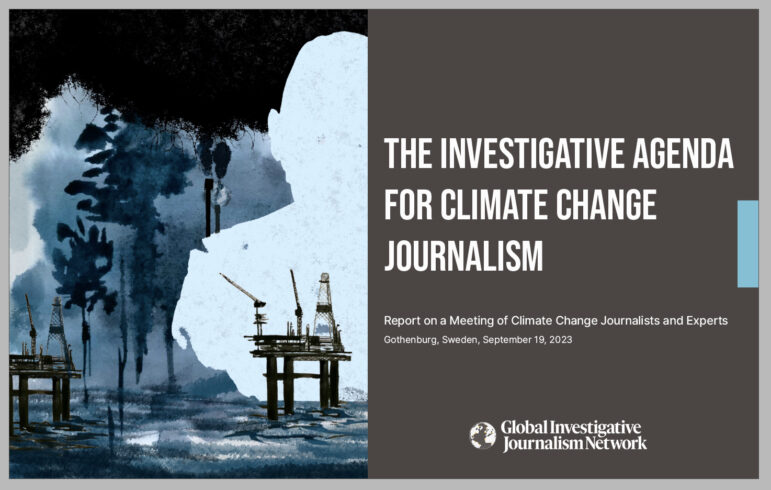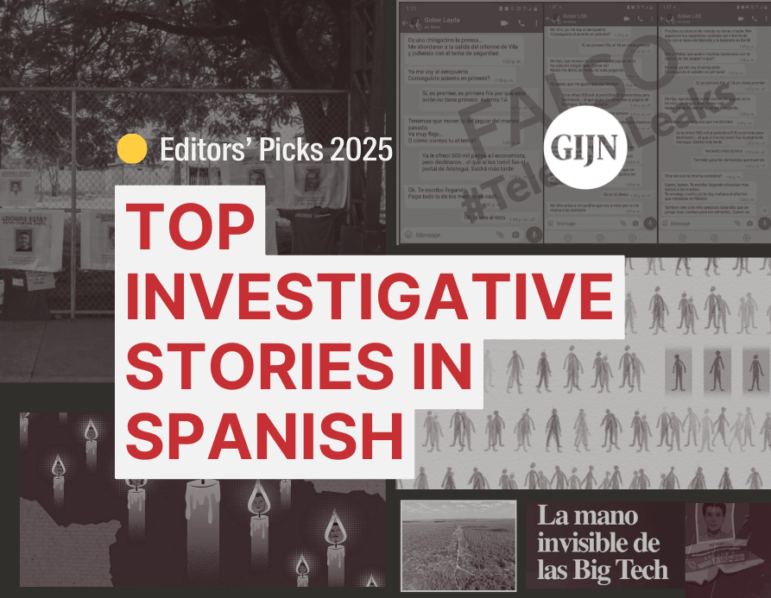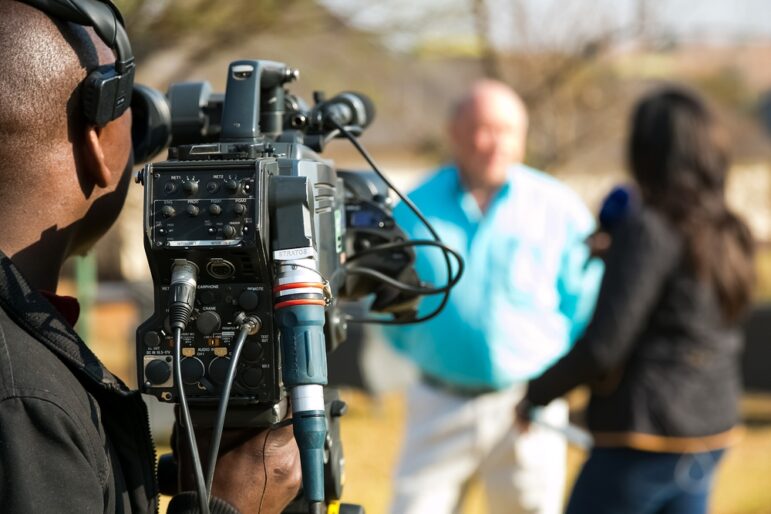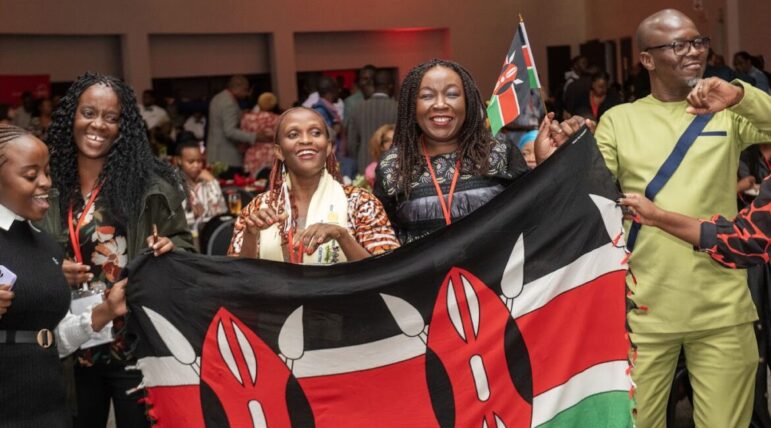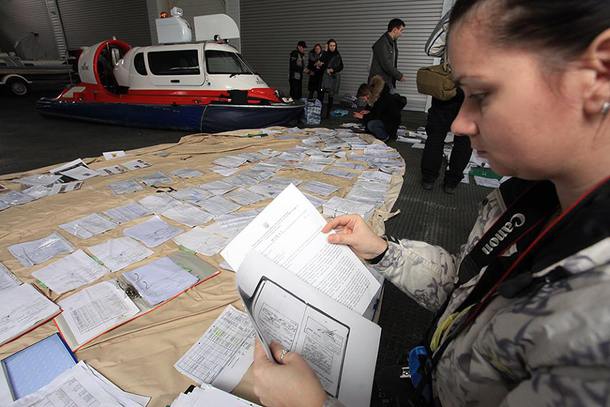

YanukovychLeaks: How Ukraine Journalists Are Making History
In the hours after Ukraine President Viktor Yanukovych fled Kiev, reports started surfacing that there were documents floating in the reservoir on his palatial 350-acre estate outside the capital. The estate is well known to the media as an off-limits location; journalists, in fact, had never entered more than 300 yards past the front gate, and even at the height of Yanukovych’s openness and good relations, journalists had only been allowed to the front door to receive cakes on journalism day.

Drying and sorting: Journalists at the palatial Yanukovych compound. Credit: Kyiv Post. © Pavel Podufalov
But now dozens of activists from the opposition Euromaidan movement were there to document the corruption and that documentation was slowly sinking into the reservoir. Someone called divers, who began retrieving more papers from the bottom of the lake. Reporters Dmytro Gnap from Slidstvo/TV Hromadske, Vlad Lavrov from the Kyiv Post, and Oksana Kovalenko from Ukrainska Pravda were the first journalists on the scene.
They would not leave again for the whole weekend.
There were tens of thousands of documents. Receipts for millions of dollars in cash. Lavish spending on exotic zoo animals and luxury goods. Records of Yanukovych’s sprawling investments. A black list of the local press.
Gnap, Lavrov, and Kovalenko quickly realized that the papers were not only explosive but in danger of being destroyed, stolen, or seized. Many were clumped in large waterlogged stacks. Others had been burned, including what reporters discerned to be a list of Yanukovych’s personal property. Adding to the tension was that nobody knew how long the journalists could be at the estate and whether government forces would suddenly knock on the door.

Members of YanukovychLeaks: Natalie Sedletska, Oleksandr Akymenko, Anna Babinets, Oleg Khomenok, and Vlad Lavrov.
The reporters then did something remarkable. They made a decision to cooperate among all the news organizations and to save first and report later. It wasn’t an easy decision. But it was clear that if they didn’t act, critical records of their own country’s history could be lost. The scene was already filling with other reporters eager to grab what stories they could and leave. In contrast, the group was joined by a handful of other like-minded journalists: Anna Babinets of Slidstvo/TV Hromadske; Oleksandr Akymenko, formerly of Forbes; Katya Gorchinska and Vlad Lavrov of the Kyiv Post. Radio Free Europe reporter Natalie Sedletska returned from Prague so she could help, and others came, too.
Lavrov, a longtime investigative journalist, realized that the team would need more help. He reached out to the Organized Crime and Corruption Reporting Project (OCCRP), a consortium of investigative centers from Europe to Central Asia, where he serves as a regional editor. From the Yanukovych compound where the internet signal was weak, he called his editors at OCCRP in Sarajevo, Bosnia, to marshal money and support. The team also reached out to veteran journalist Oleg Khomenok, an investigative trainer with two media NGOs, Internews and Scoop. Khomenok raced to the site with a laptop and agreed to act as logistical coordinator. Someone called the state archives and a heat lamp to dry documents and an archivist arrived.
The rest of this past weekend was spent laboriously fishing out documents and drying them. The reporters soon learned that if the waterlogged piles were not separated and dried, they would turn into a pasty clump that could never be rescued. The team took over a boat shed the first night and then the next day moved to an opulent guest house on the grounds to lay out more documents. It became their headquarters. A sign outside reads “Journalism Investigation in Process – Do Not Disturb.” 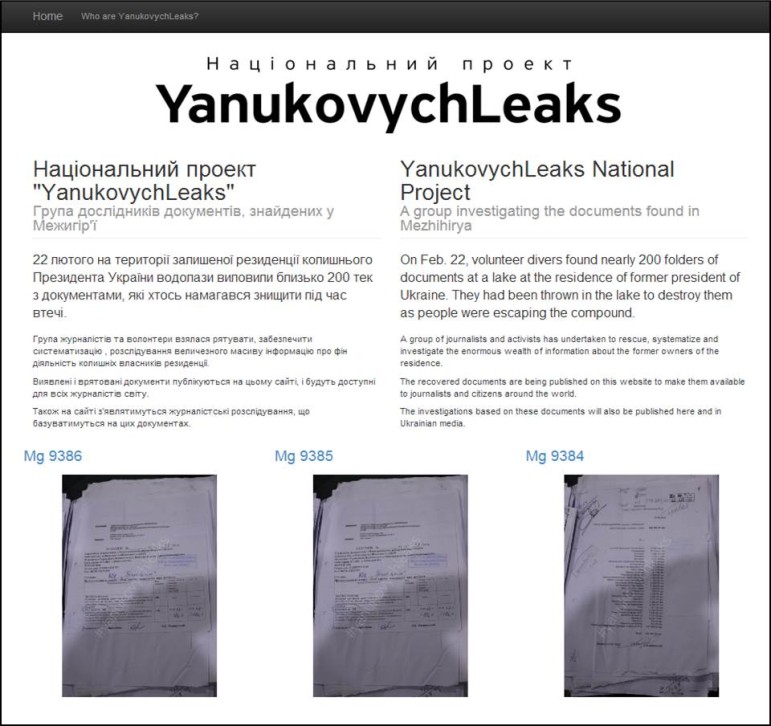
The symbolism was not lost on Lavrov. “The guest mansion was the most closed-up place in Ukraine and maybe all of Eastern Europe,” he says. “It’s a place where Vladimir Putin was hosted and it’s been turned into an investigative center by journalists and volunteers that are seeking transparency and accountability. Can you imagine? If someone told me that would be the case a week ago, I’d say they are crazy.”
At one point more than 50 people were there trying to help. Food, supplies, rides, and other needs were being continuously supplied by people supporting the work. The reporters had to systematically separate, dry, catalog, and photocopy every page. Meanwhile, every knock on the front door set off alarms in the compound as people expected the police to try to eject the citizen brigade. Armed protestors arrived to help secure the compound. Negotiations between protestors and government officials provided a backdrop. In moments of rest, the journalists read – not for their stories but to figure out where other documents might be. On Monday, reporters headed out to Suholucchya, a hunting club frequented by Yanukovych’s cronies, and Honka, Yanukovych’s main house. The process is still ongoing.
Meanwhile, within hours of Lavrov’s call to OCCRP, the consortium’s technical staff in Bosnia, Dan O’Huiginn and Adem Kuric, started designing a website and preparing a place for the documents to be hosted. Using tools from Document Cloud, O’Huiginn hacked up a quick display system. By Monday demands were being made by other journalists, teased by what had already come out, to release all the documents. In the tense situation that characterizes Ukraine, conspiracies form quickly. To demonstrate their transparency, the organizers quickly moved to get documents up. By early Tuesday, nearly 400 documents, a fraction of the estimated 20,000 to 50,000 documents, had been posted. Dozens more are being added by the hour.
The new site is www.yanukovychleaks.org.
Even as they began posting the documents as quickly as possible, the journalist group knew most of the media would ignore the deeper stories. They decided to create a 10-person team to painstakingly put together the most important stories – stories that may take weeks to report and complete.
Ukraine is, in many ways, an ideal place for this to happen. A feisty press has had their skills honed by years of reporting on secretive governments, corruption, and offshore ownership. Over the past 20 years, the Ukraine media has built an impressive tradition of investigative reporting. A half-dozen small investigative centers are alive and well around the country. Backed by groups like the Regional Press Development Institute and Western donors, Ukraine’s independent media even hosted the 7th Global Investigative Journalism Conference in 2011, bringing some 500 muckraking reporters from 75 countries to the heart of Kiev. “The gutsy Ukrainian press has taken naturally to investigative reporting,” says David Kaplan, director of the Global Investigative Journalism Network. “What you’re seeing is the result of years of training, networking, and reporting under very tough conditions.”
The journalists are looking forward to switching now from saving to reporting. Most of the work is still ahead of them. But at least they have a large share of the documents and a wonderful irony.
“Now we are occupying the site of Yanukovych’s corruption and investigating his wrong-doing,” Lavrov said. “That’s amazing.”
You can contact the Kiev team at yanukovychleaks@gmail.com.
Drew Sullivan is a veteran journalist and media development specialist who has worked for almost a decade in Eastern Europe and Eurasia. He founded the Center for Investigative Reporting in Bosnia-Herzegovina in 2004 and served as director, editor, and now advising editor to the organization. He co-founded and served as the first director of the Organized Crime and Corruption Reporting Program, a regional consortium of investigative centers, where he now serves as advising editor.



